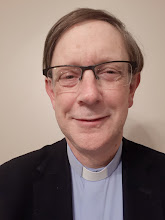14 April, 2010
My next course at St George's - the Bible and its Setting - started today, with a Eucharist at St George's Cathedral. After breakfast and introductions, we had an introductory lecture on Biblical geography by the Dean of the College, Stephen Need. He spoke about the 'holy lands' - including Jordan, Syria and Lebanon - not just the Holy Land. He also talked about biblical archaeology as we will be going to a number of archaeological sites on this course.
In the afternoon, we set out for Bait Abraham on the Mount of Olives - a place we had visited on the previous course (see my post 'Monday of Holy Week' posted on 29 March) - as there is such a great outlook over Jerusalem from the roof (and also a great lunch). Stephen pointed out various sites - the Kidron Valley, Mt Zion, the Temple Mount, the Hinnom Valley (biblical Gehenna), and the excavations of the City of David, which is outside the city walls on the southern side rising up towards the Temple Mount, plus many other sites.
The city of David excavations date back to the 10th century BC, and are built on top of older ruins from the Jebusite kingdom that King David captured, which was settled by 1800BC. The attraction of this site was a water source. The Gihon spring was just outside the ancient city walls. The site is not much to look at from afar, but it is amazing to have such an ancient and important site coming to light at the moment. We will visit it later in the course.
An interesting thing about the holy sites is that they don't have to be the actual (historical) site where things originally took place. Stephen pointed out that the place where something is remembered becomes the holy site. So for example the Temple Mount is viewed by many as the site where Abraham offered Isaac as a sacrifice, even though the real site was a long way to the south, somewhere in the Negev desert. The Mount of Olives is also identified in some traditions with the Mount of Transfiguration, although that must be a long way to the north, beyond the Sea of Galilee. What is happening here is that people want to remember important events in their own neighbourhood, and designate places that serve as places of remembrance and become hallowed because of the memory associated with them. It's a different way of looking at sacred history from ours.
One of the great things about this new course is that a friend from the Wellington Diocese, John Hughes, Vicar of the Karori parish, is on the course too. Here we are at Bait Abraham with the city of Jerusalem behind us.
25 April 2010
Subscribe to:
Post Comments (Atom)



2 comments:
Thank you so much, Peter, for posting such fascinating writings and photos. I have thoroughly enjoyed reading your comments and seeing the photos. My sincere condolences on the loss of your mother-in-law, Joan. How wonderful that you were able to remember Joan, and the family, at the eucharist service over there. Warm regards and best wishes from Joan R.
I am curious to know if behind or near this area--is there an arch-way and if you stand in the arch-way, can you see a tower or high crowned pointed building?
Please converse a little bit with me-this is very important. As you are my eyes for something I need to know. ( jjarrol@hotmail.com ) subject line put arch/tower
Post a Comment